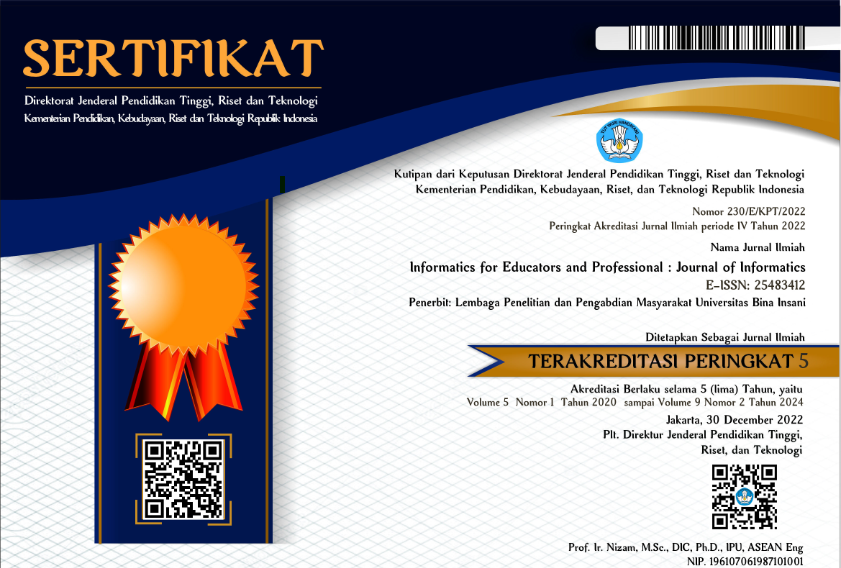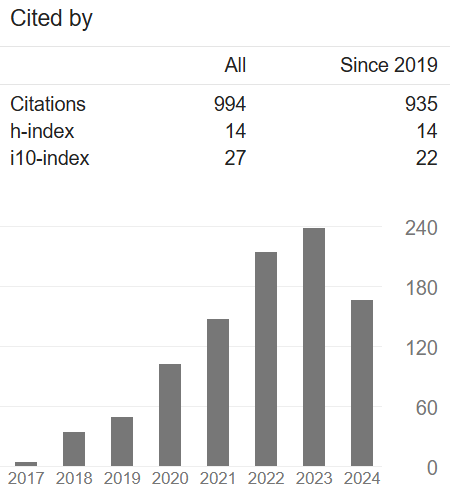Particle Swarm Optimization pada Analisa Review Software Antivirus Menggunakan Metode K-Nearest Neighbors
Abstract
Abstrak: Virus pada komputer menjadi hal yang membahayakan bagi para pengguna komputer perorangan maupun perusahaan yang telah menerapkan sistem terkomputerisasi. Virus program yang didesain untuk tujuan jahat dapat merusak bagian tertentu dari komputer, bahkan yang paling merugikan adalah dapat merusak data penting pada perusahaan. Dalam hal ini maka diciptakanlah sebuah software anti virus, perkembangan anti virus selalu lebih lambat dari virus itu sendiri, sehingga peneliti akan mengadakan penyeleksian software anti virus pada suatu opini atau berdasarkan komentar masyarakat yang telah menggunakan software anti virus produk tertentu dan dituangkan ke media online seperti komentar pada suatu situs penjualan produk tersebut. Berdasarkan ribuan komentar akan diolah dan dikelompokkan pada jenis kata teks positif dan teks negatif, dan peneliti membuat klasifikasi data dengan menggunakan metode algoritma k-Nearest Neighbor (k-NN), algoritma k-NN adalah salah satu algoritma yang sesuai dalam penelitian kali ini. Peneliti menemukan bahwa algoritma k-NN mampu mengolah data set yang sudah dikelompokan pada teks positif dan negatif khususnya dalam pemilihan teks, dan penerapan metode optimasi Particle Swarm Optimization (PSO) yang dikombinasikan dengan k-NN diharapkan mampu meningkatkan nilai akurasi sehingga datanya lebih kuat dan valid. Sebelum data set diolah menggukanan optimasi PSO hanya menggunakan metode k-NN akurasi data yang diperoleh 70,50% sedangkan hasil akurasi setelah penggunaan metode k-nn dan optimasi PSO didapatkan nilai akurasi sebesar 83,50%. Dapat disimpulkan bahwa penggunaan optimasi PSO dan metode k-NN sangat sesuai pada konsep text mining dan penyeksian pada data set berupa text.Kata kunci: Analisis Review, Optimasi Particle Swarm Optimization, Metode k-Nearest Neighbor.
Abstract: Viruses on computers become dangerous for individual computer users and companies that have implemented computerized systems. Virus programs that are designed for malicious purposes can damage certain parts of the computer, even the most detrimental is that it can damage important data on the company. In this case an anti-virus software is created, the development of anti-virus is always slower than the virus itself, so researchers will conduct an anti-virus software selection on an opinion or based on public comments that have used a particular product's anti-virus software and poured it into online media such as comment on a product sales site. Of the thousands of comments will be processed and grouped on the type of positive and negative text words, and researchers make data classification using the k-Nearest Neighbor (k-NN) algorithm method, the k-NN algorithm is one of the appropriate algorithms in this study. The researcher found that the k-NN algorithm is able to process data sets that have been grouped in positive and negative texts, especially in text selection, and the application of the Particle Swarm Optimization (PSO) optimization method combined with k-NN is expected to be able to increase the accuracy value so that the data is stronger and valid. Before the data set is processed using PSO optimization only using the k-NN method the accuracy of the data obtained is 70.50% while the accuracy results after the use of the k-nn method and PSO optimization obtained an accuracy value of 83.50%. It can be concluded that the use of PSO optimization and the k-NN method are very compatible with the concept of text mining and correction of text data sets.
Keywords: Analysis Review, k-Nearest Neighbor Method, Particle Swarm Optimization optimization
References
[1] Y. Yin, D. Han, and Z. Cai, “Explore Data Classification Algorithm Based on SVM and PSO for Education Decision,†J. Converg. Inf. Technol., vol. 6, no. 10, pp. 122–128, 2011.
[2] F. Gorunescu, Data mining: concepts and techniques. 2011.
[3] A. Zafra and S. Ventura, “Multi-instance genetic programming for predicting student performance in web based educational environments,†Appl. Soft Comput. J., vol. 12, no. 8, pp. 2693–2706, 2012.
[4] P. J. GarcÃa Nieto, E. GarcÃa-Gonzalo, F. Sánchez Lasheras, and F. J. de Cos Juez, “Hybrid PSO–SVM-based method for forecasting of the remaining useful life for aircraft engines and evaluation of its reliability,†Reliab. Eng. Syst. Saf., vol. 138, pp. 219–231, 2015.
[5] F. Zhao, Y. Liu, C. Zhang, and J. Wang, “A self-adaptive harmony PSO search algorithm and its performance analysis,†Expert Syst. Appl., vol. 42, no. 21, pp. 7436–7455, 2015.
[6] P. Kasih, “Perlindungan hukum bagi masyarakat terhadap peredaran barang palsu,†J. Univ. Atma Jaya Yogyakarta, vol. 5, no. 6, pp. 12–21, 2016.
[7] M. Berndtsson, J. Hansson, B. Olsson, and B. Lundell, Thesis Guide - A Guide for Students in Computer Science and Information Systems. 2010.
[8] D. P. Langgeni, Z. K. A. Baizal, and Y. F. a W, “Clustering Artikel Berita Berbahasa Indonesia Menggunakan Unsupervised Feature Selection,†Semin. Nas. Inform. 2010, vol. 2010, no. semnasIF, pp. 1–10, 2010.
[9] M. Abdous, W. He, and C. J. Yen, “Using data mining for predicting relationships between online question theme and final grade,†Educ. Technol. Soc., vol. 15, no. 3, pp. 77–88, 2012.
[10] M. Sholehhudin, M. Fauzi Ali, and S. Adinugroho, “Implementasi Metode Text Mining dan K-Means Clustering untuk Pengelompokan Dokumen Skripsi ( Studi Kasus : Universitas Brawijaya ),†vol. 2, no. 11, pp. 5518–5524, 2018.
















